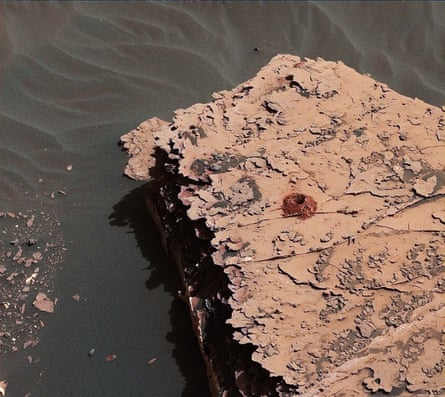Nasa’s veteran Curiosity rover has found complex organic matter buried and preserved in ancient sediments that formed a vast lake bed on Mars more than 3bn years ago.
The discovery is the most compelling evidence yet that long before the planet became the parched world it is today, Martian lakes were a rich soup of carbon-based compounds that are necessary for life, at least as we know it.
Researchers cannot tell how the organic material formed and so leave open the crucial question: are the compounds remnants of past organisms; the product of chemical reactions with rocks; or were they brought to Mars in comets or other falling debris that slammed into the surface? All look the same in the tests performed.
But whatever the ultimate source of the material, if microbial life did find a foothold on Mars, the presence of organics meant it would not have gone hungry. “We know that on Earth microorganisms eat all sorts of organics. It’s a valuable food source for them,” said Jennifer Eigenbrode, a biogeochemist at Nasa’s Goddard Space Flight Center in Maryland.
“While we don’t know the source of the material, the amazing consistency of the results makes me think we have a slam-dunk signal for organics on Mars,” Eigenbrode added. “It is not telling us that life was there, but it is saying that everything organisms really needed to live in that kind of environment, all of that was there.”
The car-sized rover, which has trundled a careful 12 miles (19.3km) since it landed in the planet’s Gale crater nearly six years ago, detected a slew of organic molecules in pieces of Martian mudstone it drilled from the ancient lake bed and heated in its onboard oven. When the samples reached 500 to 820C, the rover’s instruments detected a range of so-called aromatic, aliphatic and thiophenic vapours. The science team believes these are breakdown products of even larger organic molecules, similar to those found in coal, which were trapped in the Martian rocks in the distant past.
“To me it is amazing that we can show we have organic matter preserved for more than 3bn years in these rocks,” said Kirsten Siebach, a planetary geologist who was not involved in the work at Rice University in Houston, Texas. “This is very promising for the preservation of potential ancient life on the planet.”
“These molecules could have been part of life, but they could also have been food for life,” Siebach added. “To know that the water really was full of organic molecules really opens up the different ways that life could have existed on Mars.”
The Nasa rover has found hints of organics on the planet before. In 2015, mission scientists reported that Curiosity had detected whiffs of chlorine-containing organics in the planet’s rocks, but concerns over potential contamination and instrument glitches meant that the results did not convince everyone.
The latest findings, reported in the journal Science, are far more compelling. According to Inge Loes ten Kate, a geologist at Utrecht University in the Netherlands, “the results convincingly show the long-awaited detection of organic compounds on Mars.”

The discovery of organics in rocks mere centimetres beneath the Martian surface has raised hopes of finding richer deposits of the compounds deeper down. In those may lurk tell-tale signs of life itself, scientists say. “If we can find things like fatty acids, that would be the first potential hints of life,” said Eigenbrode.
In a separate paper published in Science, another Nasa-led team describes Curiosity’s latest measurements of the Martian atmosphere. Before the rover touched down in August 2012, missions to the red planet had already spotted methane in the atmosphere which spiked from time to time as plumes of the gas apparently rose from the planet. The discovery fuelled speculation that the gas might be the expulsions of Martian microbes eking out an existence deep underground. More mundane explanations included chemical reactions between water and Martian rocks.
The new measurements do not settle the question, but the team led by Christopher Webster at Nasa’s Jet Propulsion lab in California reveals the first regular pattern in Mars’s fluctuating methane. Tests on the Martian air show that background levels of methane rise and fall with the changing seasons. As winter gives way to summer in the northern hemisphere, the methane triples from 0.24 to 0.65 parts per billion.
Webster suspects that reservoirs of methane lie deep under the surface of Mars, perhaps in water crystals called clathrates, and leak the gas continuously. When the methane reaches the surface, it sticks to Martian dust but is released in ever-increasing quantities when the ground warms up in the summer.
“These subsurface reservoirs could be from ancient methane that was trapped underground, or from methane that is forming today. Either way it could be produced by chemistry or by microbial activity. We certainly cannot rule out a biological source at this stage,” said Webster.
Taking the measurements was no easy task. A year on Mars lasts two Earth years, so to spot a seasonal pattern in the methane levels, the scientists had to take readings for four Earth years. “That’s why it has taken us so long,” said Webster. “Talk about having patience.”